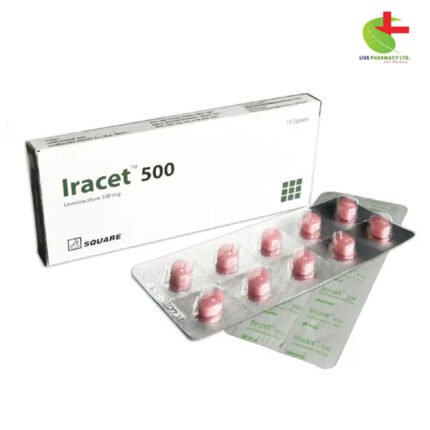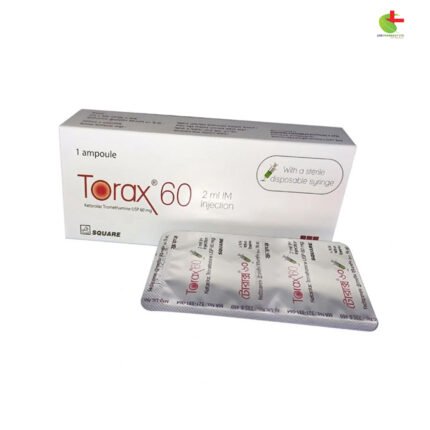Clofenac Plus
15.00৳ Piece
- This injection blends Diclofenac Sodium and Lidocaine for comprehensive pain relief and inflammation reduction.
- Ideal for addressing arthritis, musculoskeletal disorders, and traumatic injuries.
- Diclofenac’s potent anti-inflammatory properties complemented by Lidocaine’s swift local anesthesia ensure minimal discomfort.
- Administered via intramuscular injection, it swiftly alleviates acute pain and postoperative discomfort.
- Trust our expertly formulated injection for advanced pain management.
 Brand
Brand
|
Square Pharmaceuticals PLC |
|---|---|
 Generics
Generics
|
Diclofenac Sodium + Lidocaine Hydrochloride |
Indications
Our injection, containing Diclofenac Sodium, serves to alleviate pain and inflammation across various conditions, including:
- Arthritic conditions such as rheumatoid arthritis, osteoarthritis, juvenile chronic arthritis, ankylosing spondylitis, and acute gout.
- Acute musculoskeletal disorders like periarthritis (e.g., Frozen shoulder), tendinitis, tenosynovitis, and bursitis.
- Pain resulting from trauma such as fractures, low back pain, sprains, strains, dislocations, and postoperative pain in orthopedic, dental, and minor surgeries, including pain of renal colic.
Our injection also incorporates Lidocaine, acting as a local anesthetic, minimizing discomfort at the injection site, particularly following intramuscular administration, when used for the indicated conditions.
Pharmacology
Diclofenac Sodium, a potent nonsteroidal anti-inflammatory drug (NSAID) with significant analgesic and antipyretic properties, demonstrates inhibition of prostaglandin synthesis, primarily by inhibiting cyclooxygenase, an enzyme catalyzing the formation of prostaglandin precursors from arachidonic acid. Peak plasma concentration is reached within thirty minutes post-injection. Lidocaine, the included local anesthetic, acts swiftly and persistently compared to other local anesthetics, impeding nerve impulse generation and conduction by slowing depolarization, with anesthesia onset typically rapid and lasting one to two hours.
Dosage & Administration
For adults, one ampoule is administered once daily (or twice in severe cases) via intramuscular injection.
In cases of renal colic, one ampoule is administered intramuscularly once daily, with a second dose possible after thirty minutes if needed.
For children with juvenile chronic arthritis, dosages range from 1-3 mg of Diclofenac Sodium per kg of body weight daily, divided into multiple doses.
Elderly patients are advised the lowest effective dosage, tailored to age and physical condition, or as directed by a healthcare professional.
Follow physician’s advice for medication usage.
Interaction
Diclofenac may elevate plasma concentrations of Lithium and Digoxin. Caution is advised with concomitant use of anticoagulants, cyclosporine, methotrexate, quinolone antimicrobials, other NSAIDs, steroids, and diuretics due to potential interactions.
Contraindications
Contraindications include hypersensitivity to Diclofenac or Lidocaine, active or suspected peptic ulcer, gastrointestinal bleeding, asthma attacks, urticaria, acute rhinitis induced by Aspirin or other NSAIDs, Adams-Stokes syndrome, severe heart block, and hypersensitivity to any excipients used in the formulation.
Side Effects
Side effects are typically mild and transient, including gastrointestinal discomfort, nausea, diarrhea, bleeding, and rarely, injection site disorders, abscesses, or local necrosis. Lidocaine-related adverse effects primarily involve the central nervous system (CNS), manifesting as drowsiness, dizziness, disorientation, confusion, or lightheadedness.
Pregnancy & Lactation
Avoid use during pregnancy unless absolutely necessary, especially during the last trimester. Minimal amounts of Diclofenac may be present in breast milk, with no expected adverse effects on infants.
Precautions & Warnings
Close monitoring is advised for patients with severe hepatic, cardiac, or renal insufficiency, or the elderly, as NSAIDs may exacerbate renal function. Discontinue Diclofenac if abnormal liver function tests persist or worsen, or if signs of liver disease or other adverse manifestations occur.
Therapeutic Class
Belonging to the class of drugs for osteoarthritis, rheumatoid arthritis, and non-steroidal anti-inflammatory drugs (NSAIDs).
Storage Conditions
Store below 30°C in a dry, light-protected environment.













Reviews
There are no reviews yet.